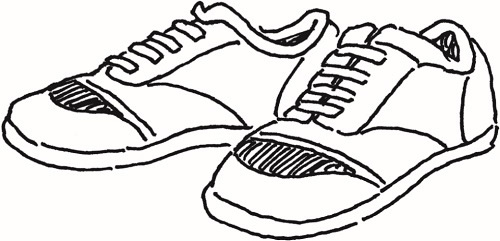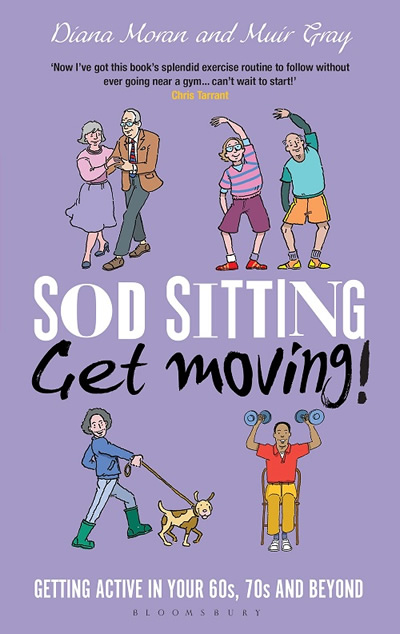Positive Health Online
Your Country

Exercise Program for the Older Years
by Diana Moran and Sir Muir Gray(more info)
listed in exercise and fitness, originally published in issue 238 - May 2017
Extracted from Sod Sitting, Get Moving! Getting Active in Your 60s, 70s and Beyond by Diana Moran and Muir Gray (Green Tree, £12.99/ £10.99 eBook)
My Exercise Plan
At the age of 77 I’m determined not only to get moving but to keep moving for as long as I possibly can. My ‘Sod sitting, get moving’ exercise plan consists of simple exercises specially designed for people who are largely neglected by the fitness industry. It’s for those of us who are later on in life; those who haven’t exercised in a while; and those who can’t do the type of exercise they used to. It also involves a range of exercises specially designed for the less active to perform in the comfort of their living room, and even while sitting down.
General Fitness Tips
- Try to take half an hour of moderate physical activity five times a week;
- Make exercise a natural part of everyday life and take the opportunity to be generally more active, anytime, anywhere;
- Learn to breathe deeply in order to encourage oxygen intake and lung elasticity;
- Stretch out your muscles before and after an exercise session or physical activity;
- Take a brisk walk for at least half an hour each day.
The ‘Sod sitting, get moving’ exercise plan consists of a head-to-toe warm-up, muscular core strength and endurance exercises plus a relaxation section. Stability drills help strengthen limbs and promote flexibility, while light aerobic work improves cardio-vascular capacity and circulation.
It’s a fact that sitting for too long can result in slack abdominal muscles and slumped posture, which encourages cramp and indigestion. Inactivity is bad for our hearts and circulation, and often results in swollen legs and feet. Unsightly varicose veins are worsened by sitting with legs crossed at the knee and can be avoided by crossing them at the ankles instead. About half the UK population suffers from some kind of leg problem and about a quarter seek treatment for conditions such as varicose veins or leg ulcers.
Good circulation is important in preventing problems. When we exercise, blood that flows into the lower leg is helped back to the heart by the calf muscles acting as a pump, and by the one-way valves in our veins. However, if the veins become damaged or the valves stop working properly, blood can gather in the lower limbs, causing some people to experience problems such as swollen ankles and tired, aching legs.
The Benefits of Exercise - Improving The Four ‘S’S
- Stamina – gives you the energy to keep going;
- Strength – helps builds strong muscles to tackle any necessary work;
- Suppleness – encourages flexibility letting you to bend and stretch;
- Skill – being active encourages co-ordination of body and mind.
(There is a fifth S: Shape - exercising expends energy (burns calories) helping control your weight - which is an important bonus).
Before beginning the programme of exercises it is important to stress that you should be responsible for ensuring how suitable any exercise is for you. Everybody’s health issues, especially those in the over-60 age group, are variable. Some people will be fitter than others, some stronger, others less flexible and some less stable.
Exercise should be comfortable and fun, and to get the most out of exercising try to join a class for older people. Most sport centres have qualified instructors who specialise in classes for the over-60s and those less mobile.
Exercise is not without its risks. To reduce the risk of any injury and/or illness, before beginning this or any exercise programme, please seek medical advice for guidance regarding appropriate exercise levels and precautions. It is particularly important to seek such advice if you suffer from an ongoing medical condition that may be affected by exercise. Special precautions are needed after surgery. Take extra care if you have had a hip replacement.
Always start any exercise programme slowly; never force or strain. While exercising, if you experience pain in your joints or muscles, stop, check your position and try again. If you feel any soreness, strain, discomfort, experience chest pain, dizziness or severe shortness of breath, stop immediately. If the pain persists seek medical advice and contact your GP. Remember: where there is pain and strain, there is no gain.

Wear comfortable clothes and supportive footwear
Equipment You May Need
You’ll probably find most of these things around the house anyway, and you don’t need to worry about buying anything unless you really want to do a particular exercise that uses something you don’t have to hand.
- Sturdy trainers;
- Mat;
- Small pillow;
- Upright armless chair;
- Two small water bottles or light hand weights;
- Exercise (resistance) bands;
- Small soft ball (e.g. a tennis ball);
- 12-inch ruler or small stick;
- Small bag of marbles.
Important Points To Remember
- Before starting any exercise programme check with your doctor that it is appropriate for you, especially if you suffer from heart disease, have high blood pressure, joint problems, back problems, if you are very overweight, if you have a serious illness or are recovering from an illness or operation;
- The ‘Sod sitting, get moving’ exercise plan is not a competition, so start slowly and build up gradually. If a movement hurts or you are suffering from dizziness – stop! Do what you can today and try again tomorrow;
- Check out location and surfaces before performing any exercises in your home or out in the garden.
- Clear a space and check that surfaces are not wet or slippery. Ensure that the support and equipment you use is strong enough to take your weight;
- Make sure you are warm enough: wear layered, loose clothing, which can be discarded as you warm up;
- Don’t exercise for at least an hour after meals, and keep drinking water to avoid becoming dehydrated.
Stretching
Exercising our bodies is important, but so too is taking time out to stretch our muscles. Strong flexible muscles enable us to perform everyday tasks, like reaching up to high shelves, bending down to put shoes on, or twisting round to pull up zips and fasten seat belts. Flexibility and suppleness help maintain mobility into older age. Muscles should be warm in order to stretch safely, so do the following stretches after a walk, gardening, a workout or a hot bath. When you begin, take care not to overstretch, listen to your body and do what is comfortable for you. Hold the stretches - as still as you can - for five seconds, gradually increasing to 10 seconds as you progress. Hold the positions, but do not bounce.
Further Information
Extracted from Sod Sitting, Get Moving! Getting Active in Your 60s, 70s and Beyond by Diana Moran and Muir Gray (Green Tree, £12.99/ £10.99 eBook)
Available from Bloomsbury and Amazon
www.bloomsbury.com/uk/sod-sitting-get-moving-9781472943767/
www.amazon.co.uk/Sitting-Moving-Diana-Moran-Muir/dp/1472943767
Comments:
-
No Article Comments available
